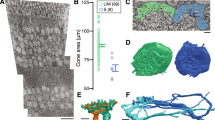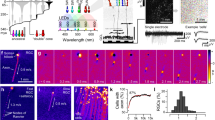Abstract
The distinct absorbance spectra of the cone photopigments form the basis of color vision, but ultrastructural and physiological evidence shows that mammalian cones are electrically coupled. Coupling between cones of the same spectral type should average voltage noise in adjacent photoreceptors and improve the ability to resolve low-contrast spatial patterns. However, indiscriminate coupling between spectral types could compromise color vision by smearing chromatic information across channels. Here we show, by measuring the junctional conductance between green-green and blue-green cone pairs in slices from the dichromatic ground-squirrel retina, that green-green cone pairs are routinely coupled with an average conductance of 220 pS, whereas coupling is undetectable in blue-green cone pairs. Together with a lack of tracer coupling and the selective localization of connexin proteins, our results show that signals in blue and green cones are processed separately in the photoreceptor layer.
This is a preview of subscription content, access via your institution
Access options
Subscribe to this journal
Receive 12 print issues and online access
$209.00 per year
only $17.42 per issue
Buy this article
- Purchase on Springer Link
- Instant access to full article PDF
Prices may be subject to local taxes which are calculated during checkout





Similar content being viewed by others
Change history
22 June 2004
added erratum PDF to AOP PDF, placed footnote in article, corrected online details added to corrected v7/n7 issue PDF
Notes
*Note: In the version of this article initially published online, the page range for reference 48 was listed incorrectly in the reference list. The correct page range should be 745—750. This error has been corrected for the HTML and print versions of the article.
References
DeVries, S.H., Qi, X., Smith, R., Makous, W. & Sterling, P. Electrical coupling between mammalian cones. Curr. Biol. 12, 1900–1907 (2002).
Baylor, D.A. & Hodgkin, A.L. Detection and resolution of visual stimuli by turtle photoreceptors. J. Physiol. (Lond.) 234, 163–198 (1973).
Detwiler, P.B. & Hodgkin, A.L. Electrical coupling between cones in turtle retina. J. Physiol. (Lond.) 291, 75–100 (1979).
Lamb, T.D. & Simon, E.J. The relation between intercellular coupling and electrical noise in turtle photoreceptors. J. Physiol. (Lond.) 263, 257–286 (1976).
Campbell, F.W. & Gubisch, R.W. Optical quality of the human eye. J. Physiol. (Lond.) 186, 558–578 (1966).
Roorda, A. & Williams, D.R. The arrangement of the three cone classes in the living human eye. Nature 397, 520–522 (1999).
Hsu, A., Smith, R.G., Buchsbaum, G. & Sterling, P. Cost of cone coupling to trichromacy in primate fovea. J. Opt. Soc. Am. A 17, 635–640 (2000).
Raviola, E. & Gilula, N.B. Gap junctions between photoreceptor cells in the vertebrate retina. Proc. Natl. Acad. Sci. USA 70, 1677–1681 (1973).
Tsukamoto, Y., Masarachia, P., Schein, S.J. & Sterling, P. Gap junctions between the pedicles of macaque foveal cones. Vision Res. 32, 1809–1815 (1992).
Herr, S., Klug, K., Sterling, P. & Schein, S. Inner S-cone bipolar cells provide all of the central elements for S cones in macaque retina. J. Comp. Neurol. 457, 185–201 (2003).
Kolb, H., Goede, P., Roberts, S., McDermott, R. & Gouras, P. Uniqueness of the S-cone pedicle in the human retina and consequences for color processing. J. Comp. Neurol. 386, 443–460 (1997).
Ahnelt, P., Keri, C. & Kolb, H. Identification of pedicles of putative blue-sensitive cones in the human retina. J. Comp. Neurol. 293, 39–53 (1990).
Chatterjee, S. & Callaway, E.M. S-cone contributions to the magnocellular visual pathway in macaque monkey. Neuron 35, 1135–1146 (2002).
De Monasterio, F.M. & Gouras, P. Functional properties of ganglion cells of the rhesus monkey retina. J. Physiol. (Lond.) 251, 167–195 (1975).
Dacey, D.M. & Lee, B.B. The 'blue-on' opponent pathway in primate retina originates from a distinct bistratified ganglion cell type. Nature 367, 731–735 (1994).
Lee, B.B., Martin, P.R. & Valberg, A. The physiological basis of heterochromatic flicker photometry demonstrated in the ganglion cells of the macaque retina. J. Physiol. (Lond.) 404, 323–347 (1988).
Dacey, D.M., Lee, B.B., Stafford, D.K., Pokorny, J. & Smith, V.C. Horizontal cells of the primate retina: cone specificity without spectral opponency. Science 271, 656–659 (1996).
Kryger, Z., Galli-Resta, L., Jacobs, G.H. & Reese, B.E. The topography of rod and cone photoreceptors in the retina of the ground squirrel. Vis. Neurosci. 15, 685–691 (1998).
Vaney, D.I. Many diverse types of retinal neurons show tracer coupling when injected with biocytin or Neurobiotin. Neurosci. Lett. 125, 187–190 (1991).
Mills, S.L. & Massey, S.C. A series of biotinylated tracers distinguishes three types of gap junction in retina. J. Neurosci. 20, 8629–8636 (2000).
Bennett, M.V. et al. Gap junctions: new tools, new answers, new questions. Neuron 6, 305–320 (1991).
Beyer, E.C., Paul D.L. & Goodenough D.A. Connexin family of gap junction proteins. J. Membr. Biol. 116, 187–194 (1990).
O'Brien, J., al-Ubaidi, M.R. & Ripps, H. Connexin 35: a gap-junctional protein expressed preferentially in the skate retina. Mol. Biol. Cell 7, 233–243 (1996).
Teubner, B. et al. Functional expression of the murine connexin 36 gene coding for a neuron-specific gap junctional protein. J. Membr. Biol. 176, 249–262 (2000).
Feigenspan, A., Teubner, B., Willecke, K. & Weiler, R. Expression of neuronal connexin36 in AII amacrine cells of the mammalian retina. J. Neurosci. 21, 230–239 (2001).
Mills, S.L., O'Brien, J.J., Li, W., O'Brien, J. & Massey, S.C. Rod pathways in the mammalian retina use connexin 36. J. Comp. Neurol. 436, 336–350 (2001).
Deans, M.R., Volgyi, B., Goodenough, D.A., Bloomfield, S.A. & Paul, D.L. Connexin36 is essential for transmission of rod-mediated visual signals in the mammalian retina. Neuron 36, 703–712 (2002).
Lee, E.J. et al. The immunocytochemical localization of connexin 36 at rod and cone gap junctions in the guinea pig retina. Eur. J. Neurosci. 18, 2925–2934 (2003).
Feigenspan, A. et al. Expression of connexin36 in cone pedicles and OFF-cone bipolar cells of the mouse retina. J. Neurosci. 24, 3325–3334 (2004).
Dizhoor, A.M. et al. Recoverin: a calcium sensitive activator of retinal rod guanylate cyclase. Science 251, 915–918 (1991).
McGinnis, J.F., Stepanik, P.L., Jariangprasert, S. & Lerious, V. Functional significance of recoverin localization in multiple retina cell types. J. Neurosci. Res. 50, 487–495 (1997).
Haverkamp, S., Grünert, U. & Wässle, H. Localization of kainate receptors at the cone pedicles of the primate retina. J. Comp. Neurol. 436, 471–486 (2001).
Kraft, T.W. Photocurrents of cone photoreceptors of the golden-mantled ground squirrel. J. Physiol. (Lond.) 404, 199–213 (1988).
Schneeweis, D.M. & Schnapf J.L. Photovoltage of rods and cones in the macaque retina. Science 268, 1053–1056 (1995).
Williams, D.R., MacLeod, D.I. & Hayhoe, M.M. Punctate sensitivity of the blue-sensitive mechanism. Vision Res. 21, 1357–1375 (1981).
De Monasterio, F.M., Schein, S.J. & McCrane, E.P. Staining of blue-sensitive cones of the macaque retina by a fluorescent dye. Science 213, 1278–1281 (1981).
Szél, A., Diamantstein, T. & Rohlich, P. Identification of the blue-sensitive cones in the mammalian retina by anti-visual pigment antibody. J. Comp. Neurol. 273, 593–602 (1988).
Curcio, C.A. et al. Distribution and morphology of human cone photoreceptors stained with anti-blue opsin. J. Comp. Neurol. 312, 610–624 (1991).
Mariani, A.P. Bipolar cells in monkey retina selective for the cones likely to be blue-sensitive. Nature 308, 184–186 (1984).
Kouyama, N. & Marshak, D.W. Bipolar cells specific for blue cones in the macaque retina. J. Neurosci. 12, 1233–1252 (1992).
Calkins, D.J., Tsukamoto, Y. & Sterling, P. Microcircuitry and mosaic of a blue-yellow ganglion cell in the primate retina. J. Neurosci. 18, 3373–3385 (1998).
Rieke, F. & Baylor, D.A. Origin and functional impact of dark noise in retinal cones. Neuron 26, 181–186 (2000).
Chichilnisky, E.J. & Baylor, D.A. Receptive-field microstructure of blue-yellow ganglion cells in primate retina. Nat. Neurosci. 2, 889–893 (1999).
Jacobs, G.H. Spectral sensitivity and colour vision in the ground-dwelling sciurids: results from golden mantled ground squirrels and comparisons for five species. Anim. Behav. 26, 409–421 (1978).
Nathans, J. The evolution and physiology of human color vision: insights from molecular genetic studies of visual pigments. Neuron 24, 299–312 (1999).
Ghosh, K.K., Martin, P.R. & Grünert, U. Morphological analysis of the blue cone pathway in the retina of a New World monkey, the marmoset Callithrix jacchus. J. Comp. Neurol. 379, 211–225 (1997).
Yang, G. & Masland, R.H. Receptive fields and dendritic structure of directionally selective retinal ganglion cells. J. Neurosci. 14, 5267–5280 (1999).
Hornstein, E.P., Verweij, J. & Schnapf, J.L. Electrical coupling between red and green cones in primate retina. Nat. Neurosci. 7, 645–650 (2004).
Nunn, B.J., Schnapf, J.L. & Baylor, D.A. Spectral sensitivity of single cones in the retina of Macaca fascicularis. Nature 309, 264–266 (1984).
Laughlin, S.B. Retinal function: coupling cones clarifies vision. Curr. Biol. 12, R833–R834 (2002).
DeVries, S.H. & Schwartz, E.A. Kainate receptors mediate synaptic transmission between cones and 'off' bipolar cells in a mammalian retina. Nature 397, 157–160 (1999).
Acknowledgements
We thank J. McGinnis for the anti-recoverin antibody; and S. Massey and D. Schneeweis for critically reading the manuscript. This work was supported by the US National Institutes of Health (grant EY12141) and Research to Prevent Blindness.
Author information
Authors and Affiliations
Corresponding author
Ethics declarations
Competing interests
The authors declare no competing financial interests.
Rights and permissions
About this article
Cite this article
Li, W., DeVries, S. Separate blue and green cone networks in the mammalian retina. Nat Neurosci 7, 751–756 (2004). https://doi.org/10.1038/nn1275
Received:
Accepted:
Published:
Issue Date:
DOI: https://doi.org/10.1038/nn1275
This article is cited by
-
Interphotoreceptor coupling: an evolutionary perspective
Pflügers Archiv - European Journal of Physiology (2021)
-
Characterization of connexin36 gap junctions in the human outer retina
Brain Structure and Function (2016)
-
A color-coding amacrine cell may provide a blue-Off signal in a mammalian retina
Nature Neuroscience (2012)
-
The diverse functional roles and regulation of neuronal gap junctions in the retina
Nature Reviews Neuroscience (2009)
-
Making selective 'cone-ections'
Nature Neuroscience (2006)



